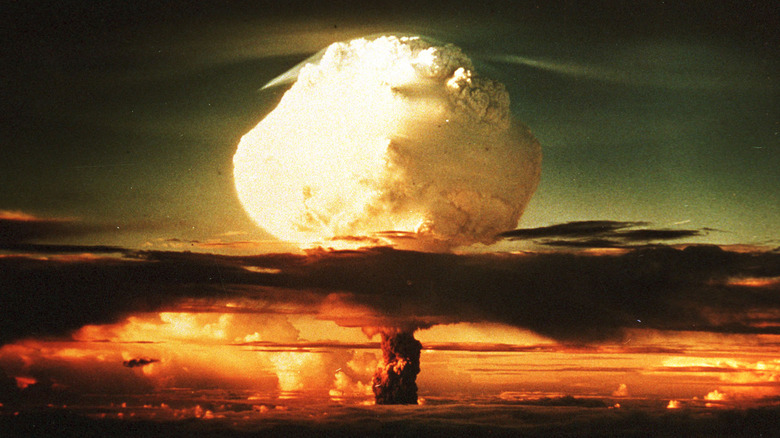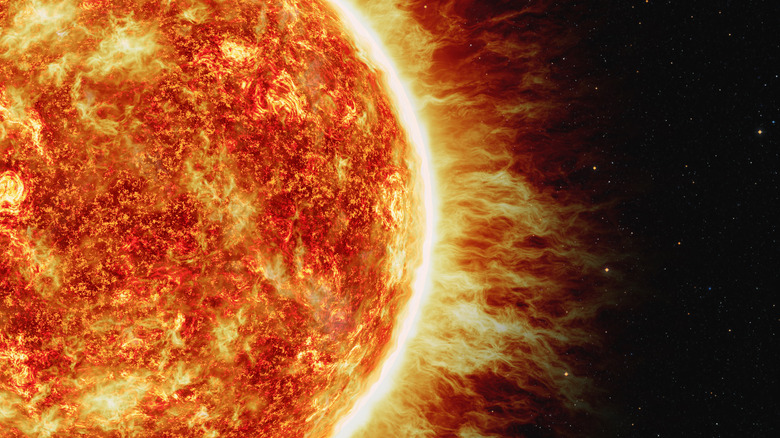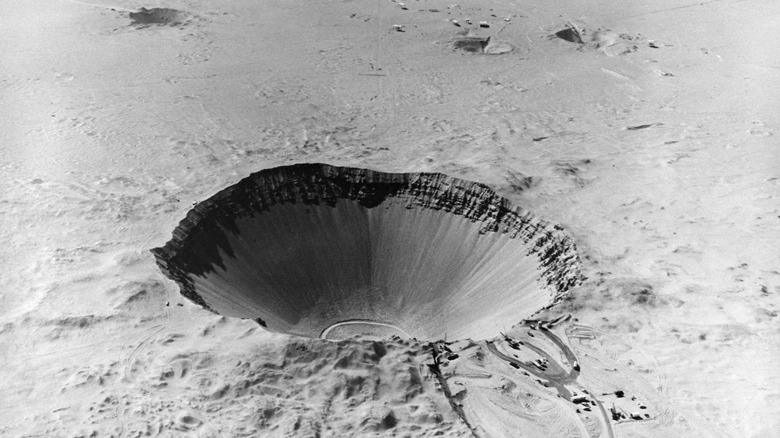Here's Why A Hydrogen Bomb Is So Much More Devastating Than An Atomic Bomb
Science fiction is replete with doomsday scenarios and world-ending weapons. From the Death Star's planet-detonating mega-laser in "Star Wars" to a multidimensional supercomputer folded into a single, intelligent particle from Liu Cixin's "The Three-Body Problem" (spoiler, whoops!). But truth be told, you don't need such overkill weaponry to rid the cosmos of humans. You just need a single-celled virus, or a stutter in the beating of a single heart (times 8 billion humans alive). And as far as manmade superweapons are concerned, we've already built our world-ender: the atomic bomb. Except that there's an even more powerful bomb in existence: the hydrogen bomb.
The two atomic bombs dropped on the Japanese cities of Hiroshima and Nagasaki — Little Boy and Fat Man — killed an estimated 320,000 people taking the initial detonation, nuclear fallout, cancer, etc., into account. The explosive yield of those bombs equaled 15 and 21 kilotons, respectively. Those bombs are tiny baby specks in comparison to the most powerful bomb ever made, however: the Tsar Bomba from the Soviet Union, first tested in 1961. That bomb equaled 50,000 kilotons and sent its mushroom cloud over halfway to the altitude of spacecraft in Earth's orbit.
How in the world did such a bomb produce such unimaginably destructive power? Well, the Tsar Bomba was a different type of bomb from Little Boy and Fat — it was a hydrogen bomb. Unlike atomic bombs, hydrogen bombs detonate using a more complex, multiphase process that first splits atoms (fission) and then smashes them back together (fusion).
The power of the sun
Sometimes hydrogen bombs are called "thermonuclear" bombs, which get their "thermo-" prefix from the immense, absurd amount of heat they generate when they explode. To help explain the ridiculousness of such weapons, a 1-megaton explosion can produce heat equal to 212 million degrees Fahrenheit at its center — that's seven times hotter than the center of our sun. Remember the Tsar Bomba hydrogen bomb? It had a yield of 50,000 kilotons or 50 megatons. That's 10.6 billion degrees Fahrenheit, or (ready?) 392 times hotter than the center of our sun. So why didn't the Earth just dissolve or whatever? The bomb's explosion lasted only an instant. In a very real sense, our sun is a continually detonating space orb of hydrogen bombs.
The sun's gravity is so immense that it yanks atoms towards its core. Those atoms strike other atoms and release energy that quite literally lights up a black and cold cosmos — that's the "nuclear fusion" happening inside a hydrogen bomb. Specifically, the sun fuses hydrogen to make helium, and the excess energy produced by this fusion gets shed, cast into space, and makes it all the way to Earth to keep plants green and people tanned. As Euro-fusion outlines, the sun fuses two pairs of hydrogen protons to get two molecules of helium, which then fuse to get a heavier type of helium. Along the way we get two derivatives of hydrogen: deuterium and tritium. And human-man hydrogen bombs? They use deuterium and helium, too.
Split, then fuse
It's more or less accurate to say that a hydrogen bomb is like an atomic bomb, plus an extra step. Atomic bombs split atoms, and that's that. Hydrogen bombs split atoms (fission) and then recombine them (fusion), using the energy from the fission step to power the fusion step. This is why the magnitude of a hydrogen bomb's yield is so unbelievably massive.
The Center for Arms Control and Non-Proliferation goes into further detail about the hydrogen bomb detonation process, while Radio Free Europe has a diagram that clarifies the process. First, we've got to go through the entire atomic bomb explosion using a spherical bomb. This bomb has a hollow plutonium or uranium core filled with hydrogen. Conventional explosives detonate towards the inside of this bomb, not the outside. The plutonium or uranium core collapses and causes a molecular chain reaction that splits hydrogen atoms (fission) and creates an atomic explosion.
As for the hydrogen bomb step, the energy from the above-described atomic fission gets reflected back inside the bomb. That energy gets bounced around a bit inside a second, conical chamber, and releases tritium that fuses with deuterium — like the sun, remember. That nuclear fusion releases energy that gets projected outwards and creates a thermonuclear explosion. There are loads of other steps involved — this was the work of brilliant physicists, mind you — but for our purposes we can say that a hydrogen bomb is humanity's best attempt at recreating the sun on Earth.
Testing the hydrogen bomb
Those who've seen Christopher Nolan's "Oppenheimer" might remember Edward Teller. Teller wasn't satisfied with a regular 'ole atomic bomb and wanted to go the extra step and make a hydrogen bomb. He got vetoed, thankfully, because everyone involved knew it was overkill — an atomic bomb is bananas enough. And besides, in a practical warfare scenario, conventional explosions are easy to use and will do the job, anyway. Humans are made of flesh and bone, right?
Eventually though, as the Atomic Heritage Foundation explains, Teller got his chance to do his experiments. And just like how a hydrogen bomb's construction builds on an atomic bomb, Teller's experiments built on the work of the Manhattan Project – it even used some of the same physicists still at Los Alamos following the end of World War II. All those involved worked bit by bit from 1946 to 1949 even after Hiroshima and Nagasaki had been bombed. President Harry Truman decided to accelerate the development of the hydrogen bomb come 1950, to the dismay of the Atomic Energy Commission.
Teller and company turned their attention towards isolated Pacific Ocean islands to conduct their tests. The small hydrogen bomb called the "George" proved successful in 1951, and got its sequel with the "Mike shot" in 1952 in the Marshall Islands. Finally, 1954 saw Operation CASTLE drop six hydrogen bombs in succession, including the largest, Bravo. One by one, other countries followed suit, including Israel, the U.S.S.R., The U.K, China, France, Pakistan, India, and North Korea.


